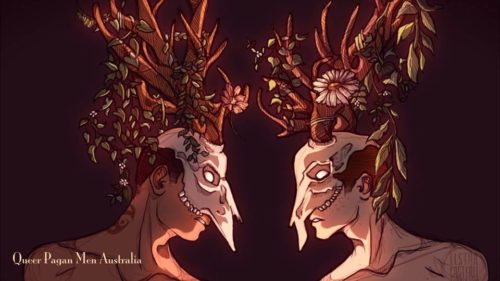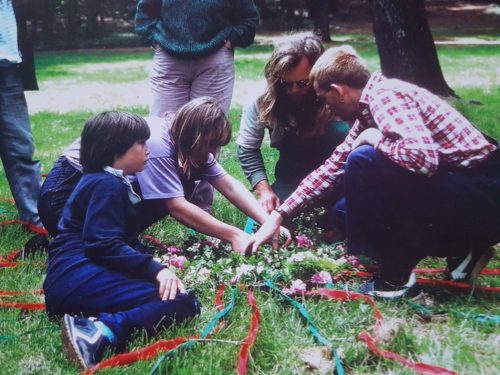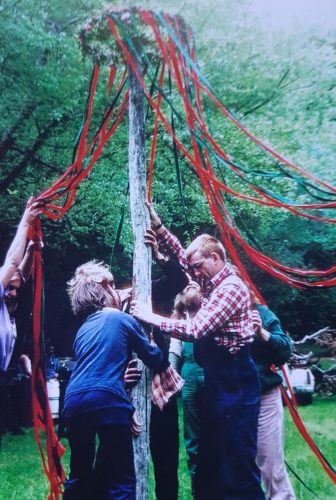![]()
Queer Paganism in Australia today is multifaceted and vibrant with a large number of publicly active traditions, groups, and meetups that are queer oriented or queer inclusive. The most notable of these is Queer Pagan Men Australia.

[Image Credit: https://llstarcasterll.deviantart.com/]
Queer Pagan Men Australia
Queer Pagan Men Australia (QPMA) was founded by Ryan McLeod and Buck Agrios in 2012 with the mission of providing a safe space for men who love men to explore their spiritual beliefs, sacred sexuality, roles in community, and practice in the craft as queer men.
In Alexandrian witchcraft, McLeod finds that his position is primarily a fertility focused one, However he also sees the importance of LGBT people having opportunities to connect with one another in Australia, and to share their unique experience and perspectives of Paganism.
“The Australian Pagan community is spread across a huge distance,” says McLeod. “An online group was great starting point from which to organise face-to-face meetups. Facebook was becoming a constant tool for communication.”
Buck Agrios will soon become the first Australian initiate of the Unnamed Path, which was founded in America by Eddy Gutérrez (Hyperion) and consists of four main areas of skill and training: Magic and Prophecy, Energy Healing, Shamanic Journey Work and Death Walking.
“It took me over 6 years of research, questioning, listening, online discussions and soul-searching before I finally decided to begin formal study,” Agrios says. “I was keen to find a path that reflected my experience and also would help me build a deeper practice both spiritually and magically.”
Agrios, who also identifies as a Reclaiming witch and a Dionysian, agrees that the Australian Pagan community is very far-flung across great distance, and that this is a hindrance to face-to-face contact.
“It was back in March 2011 that a small group of gay male witches and I were looking at how we could hold an event specifically for queer Pagan Men in Australia similar to what we saw happening in the USA with events such as Between the Worlds,” said Agrios
“We were seeking a way to learn our unique stories, explore our witchcraft history and learn about gay and queer inclusive paths out there. We realised we needed to find the community first.”
This originally came in the form of a Yahoo group, which lasted around a year before QPMA was born. What started as an online discussion and networking group soon grew into real life meetups, which now take place regularly across three states.
The group is also hosting its first full day event, Roots and Bones, in Melbourne in January 2018. The day is intended to be interactive day, filled with workshops and ritual. Guest presenters from the USA and Australia will teach and present on a range of topics and queer-inclusive paths of Paganism.

Both McLeod and Agrios have noticed the impact that the marriage equality plebiscite [currently underway in Australia is having on its queer Pagan community.
“Right now in Australia the LGBT community is hurting,” Agrios says. “I do not want to get into the politics of what is happening here, but it is a reminder that we need to listen more to our ancestors of the heart as men who love men.”
McLeod agrees, saying: “The plebiscite is an obscure use of our constitution. We don’t require the Australian population to vote to redefine the laws around marriage. The law was changed as late as 2004 by the Prime Minister of the time John Howard.”
The general voting on same-sex marriage will be open until Nov. 7.
“This vote has much more to do with the current government and its attitudes than a genuine desire for Australians to have a say. It has been incredibly damaging to the mental health, safety, and well-being of the queer community,” McLeod adds.
“As a queer person, it is distressing to think that the entire country is going to have a say on your rights as a human being. The underlying message there is that queer people are somehow inherently ‘less than’ and are not deserving of rights afforded to all other Australians.”
“We must remember (early queer Pagans’) battles and learn to call on their strength,” Agrios urges. “Much of our queer history has been lost or forgotten and as a queer pagan man I feel it is important that we look back and find the truth of our past and that will help us shape our future.”
And what will that future look like? Both men hope it is one of acceptance and tolerance, and that organisations such as QPMA can help queer Pagans feel more accepted and valued by the wider LGBT community.
“The future is in acceptance and celebration of our differences while acknowledging our past,” Agrios continues.
“We have so much to still learn from our lost histories as Queer Pagans and I look forward to seeing more of it uncovered and shared with pride.”
David O’Connor and the Circle of the Dark Mother
A lesser known but arguably one of the most important figures in the formative days of Australia’s queer Pagan community is David O’Connor.

David O’Connor (right) preparing the maypole with Michel Marold (second from right) at the Mount Franklin Pagan Gathering.in the late 1980s. [courtesy]
In the nearby town of Castlemaine, O’Connor, a gay witch from St Kilda, Melbourne, got off a train with a friend and into a cab.
“Take us to the witches!” were the only directions he gave, and the driver – being well versed in all things Castlemaine – knew exactly where to go.
“We’d all just gathered on the flat and, all of a sudden, a taxi turned up. It came driving down the middle [of our bush property],” remembers Linda. “And a couple of guys jumped out.”
One of them greeted Michel like a long lost friend. At the time he assumed that this was someone he had just forgotten meeting before.
“We ran up to each other, dancing around and hugging. When we parted, we looked at each other and said, ‘who are you? I don’t know you!’.”
That night was the beginning of a firm friendship between Mick and David, who around that time had started to set himself up as “the unofficial witch” of Melbourne’s LGBT community, providing spells and rituals to those who needed them.
Mick helped with music and chants for many of the rites, which often focused on health and fertility, and were informed and inspired by David’s work as a nurse and later as one of the state’s first male midwives.
Linda also became a very close friend of David’s. During the 1980s, he acted as Magister and Master of Ceremonies at many of the early Mount Franklin Pagan Gatherings, which Linda and Michel still organise today.
In the mid-1980s, David was among the founding members of Melbourne’s iconic Midsumma festival, after deciding he wanted to host an annual LGBT festival.
“He wanted an annual event and being a Pagan he felt it should have ties to a seasonal festival,” Michel remembers.
“So I said, ‘if you want colour and partying, why not Midsummer?’.”

The middle of the 1980s was also when David began to form his own Pagan tradition. After several years of working rituals with both male and female working partners, David came to the conclusion that he could not see himself becoming the High Priest of a coven or a working group in the more traditional sense.
“He agreed with fertility religions and worked within them for many years,” Mick explains. “But it was not the only framework he was drawn to.”
David formed the Circle of the Dark Mother, a working circle for gay Pagan men. According to Mick the tradition, created by David, was a magical one with traditional witchcraft leanings. Unlike many others from around the same time, the coven worked with a sterile goddess figure.
“These were men who could not have or did not want children.” Linda remembers. “But they supported society in their own way so that it was a society fit to raise children in. David loved children.
She adds, “He was an unofficial uncle to my children. He doted on his own nephews, too. He was very fond of his family.”
The group initially had eight members aside from David himself. In or around 1987, he tried opening the circle to straight men as well, but Mick claims this was not something that worked very well or for very long.
“Despite all his bluff and bluster, he really knew his stuff. He had all his mythology worked out.” Mick recalls.
“Yes, he was a really talented ritualist, too.” Linda agrees.
When asked to speculate on why this was so, the pair agree that O’Connor’s background in the Catholic church definitely played a part. “He used to say that altar boys ended up making the best High Priests,” Mick says.
“Because they’re trained in ritual … They’re disciplined in ritual.”
The Legacy
By 1990 the AIDS epidemic was approaching its worst point in Melbourne. David’s role now included acting as a “death chaplain” for Melbourne’s Pagan and LGBT communities. With Mick’s help, he performed rituals in and around the inner city area focused on death, healing and fertility. He also trained others in pathworking techniques, incense making, and more.
The epidemic reached its peak in the early 1990s, and, of the original group of eight members of the Circle of the Dark Mother, only two survived.
“The AIDS epidemic of the early nineties destroyed the gay Pagan community in Melbourne. Any working groups (that O’Connor was involved with) literally died because of it.” Mick states.
David continued to work and train within the Pagan community before passing away in 1995. His funeral was a mixed Christian and Pagan affair, at his request. A ritual was later held at Mount Franklin, where some of his ashes were scattered.
“We miss him so much,” Linda says, sadly. “Who knows what other amazing things were destroyed (by the AIDS epidemic) all over the world, in every human endeavour. Young geniuses and amazing people all left us too early and too quickly.”
“What was really lost was the sense of fun. The sense of style. He was mischievous. He was a laugh a minute, and yet he’d step into the circle and he was such an accomplished High Priest.”
While the Circle of the Dark Mother no longer exists as a working coven, David O’Connor’s legacy to the LGBT and Pagan communities lives on in the individuals and small groups still practicing Australia’s first queer witchcraft tradition today, as well in the colour and celebration of the Midsumma festival.
Recent years have seen more queer people reaching out to find traditions and practices that resonate with them. There are now many men, women, and others working hard to provide safe, inclusive and constructive environments and traditions in which queer Pagans can thrive in this country.
In many ways, they are continuing the important work started by O’Connor. And while we are fortunate enough to have more queer traditions coming to our shores and countless others have followed in his footsteps, David O’Connor was the first.
Author’s Note:Some names have been changed by request to protect privacy.
* * *
The views and opinions expressed by our diverse panel of columnists and guest writers represent the many diverging perspectives held within the global Pagan, Heathen and polytheist communities, but do not necessarily reflect the views of The Wild Hunt Inc. or its management.
The Wild Hunt is not responsible for links to external content.
To join a conversation on this post:
Visit our The Wild Hunt subreddit! Point your favorite browser to https://www.reddit.com/r/The_Wild_Hunt_News/, then click “JOIN”. Make sure to click the bell, too, to be notified of new articles posted to our subreddit.

Pingback: Queer Pagan Men Australia – The Dionysian Artist
Pingback: Queer Paganism in Australia – Winter's Tidings